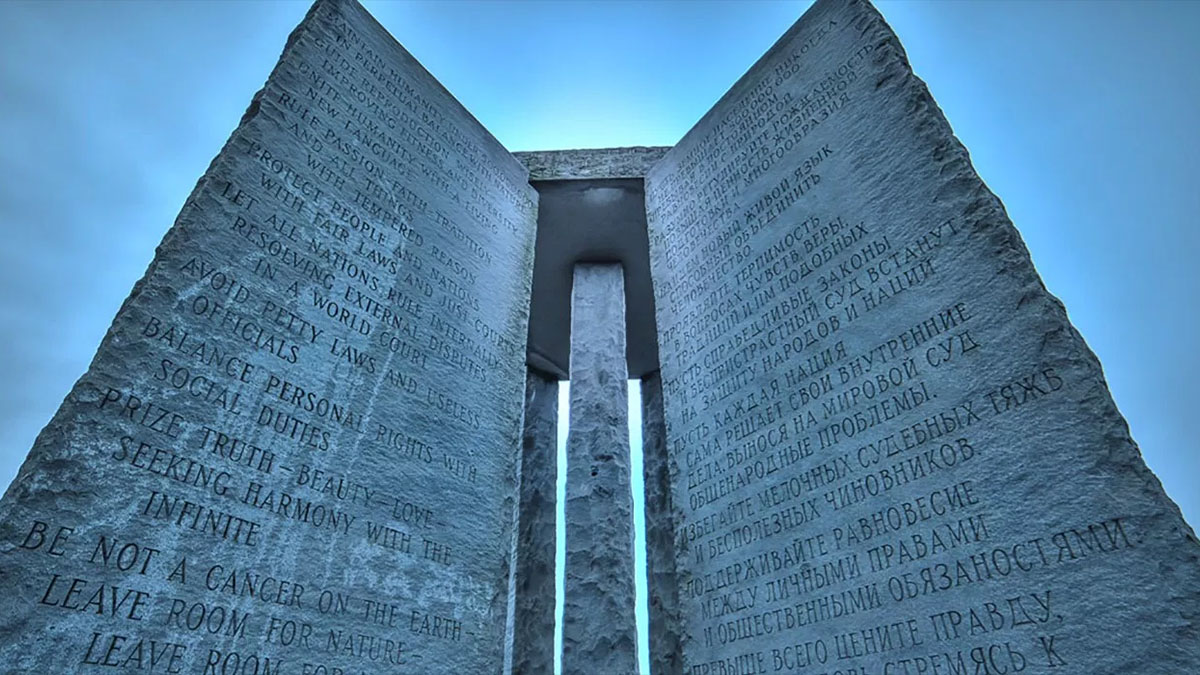the rosicrucian stonehenge

A little while ago, Wired published an article about a huge stone monument built by a group represented by a mysterious person who went only by the odd moniker R.C. Christian. Various crackpots like Mike Dice declare it Satanic (which let’s face it, is just a label rabid fundamentalists give anything they don’t like) and quite a few people would really like to know who was behind its construction and why since the Guidestones are nothing less than an astronomical calendar with a list of instructions for a post-apocalyptic world.
The Georgia Guidestones are actually a great example of how monuments we view today as bizarre and mysterious come to be. While we construct all sorts of theories involving aliens, secret cults and lost civilizations, the truth is right in front of our noses. These monuments are designed to be huge, mysterious and awe inspiring. They’re built to make people ask and wonder while taking in the monuments’ cryptic messages outside of a normal cultural context. For the Guidestones, the big question is what motivated a mysterious, intentionally nameless group to design, plan and fund the project, and what message they wanted to convey. Thankfully, they left a few clues…
The intricate stone arrangement in question here, bears all the trademarks of Rosicrucianism, a sect of Christian mystics who developed incredibly complex and elaborate texts on theology, often trying to mix in scientific updates to their permutations of Biblical stories and references. Just the fact that their representative went by the name R.C. Christian already speaks volumes. The mythical founder of the Rosicrucians was an ancient alchemist by the name of Christian Rosenkreuz, or Rose Cross. The term Rose Cross also refers to the 18th degree in the Scottish Rite of Freemasonry, the Knight of the Rose Croix.
This is one of the reasons why conspiracy theorists who still can’t accept that the Leo Taxil hoax was just a prank at the expense of church officials, want to call the Guidestones a Satanic monument. There’s a sign of the Freemasons in its history. But in reality, Masonic legends are a homunculus of several high profile esoteric and occult traditions based mostly on the Old Testament, and their rites and orders reflect that. The actual doctrine of the Rosicrucians is very different and focuses mostly on something called spiritual alchemy, a sort of human transcendence beyond the base forms of the flesh and blood.
Maybe, fearing that our civilization could one day collapse without getting there, they wanted to preserve what they thought were the basic guidelines for a future society that could fulfill their goal. And just to make sure they would catch the attention of post-apocalyptic leaders, they wanted to build a multi-lingual monument guaranteed to catch their attention. But it seems even more likely that it was created and financed by a doctor named Herbert Hinie Kersten, according to the correspondence between the banker responsible for overseeing the final construction and “R. C. Christian.”
Unfortunately, this information casts the Guidestones in a far less flattering light since Kersten was at one point a fan of David Duke, calling the infamous Klansman’s views popular among “reasonable” Americans in a letter published in the South Florida Sun Sentinel. He was also a devout Roman Catholic, leading some to suspect that this is what the R. C. really meant in his chosen pseudonym, and the apocalypse he had in mind was a nuclear war with the Soviet Union, a threat floated daily at the time of the monument’s construction and imminently reasonable to assume could be just around the corner.
But there’s still plenty of mysteries left even if we do assume that Kersten designed the paid for the Guidestones. Who was in the small group who’d expand the monument according to his letters and instructions? And if the instruction to “guide reproduction wisely” was a call to eugenics, as some assumed, why did he conclude it with “improving fitness and diversity,” enraging actual white supremacists? Why would it be in multiple languages, including Swahili, and encourage environmentalism and other notions the Western far right finds viscerally repugnant?
Could it be that while planning the monument, he had a change of mind after giving an actual nuclear apocalypse some honest, deep thought? We’ll probably never know the answers to these questions, which brings us back to the original point. If a few decades was enough for a strange, obscure monument to become shrouded in mystery, just imagine what a few millennia would do, especially if many of the surrounding records were lost to time. Although after being bombed in the middle of the night, the Guidestone’s fate seems uncertain even for the near future, much less for the next few thousand years.
update: This article has been updated and expanded in light of the attack on the monument in 06.06.2022 with additional details about the identity of R. C. Christian that surfaced in 2010, a year after the original version was published.





